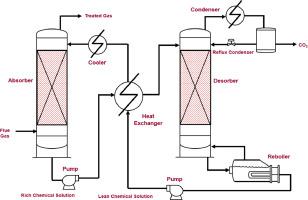CO2 absorption-desorption cycles: Progress, gaps, and future
引用次数: 0
Abstract
In order to control global warming and CO2 emissions to the atmosphere, carbon capture from the carbon production source is considered the short- to midterm solution. The CO2 absorption-desorption process is recognised as a mature process that has been implemented for many years. However, this process has several weaknesses, such as the considerable energy requirements for regeneration in the desorber unit and degradation of solvent when using amine solutions. In this study, we examine several elements of absorption-desorption cycles for CO2 capture. This includes modelling, experimentation categorised by the unit operation employed, techno-economic analysis, optimisation, control strategies, and life cycle assessments. It discusses steady-state, dynamic, and data-driven based models, along with a selection of experimental studies conducted at the laboratory scale, detailing solvents used, column characteristics, and equipment specifications. Furthermore, it examines optimisation techniques, techno-economic assessments (TEA), and industrial applications, categorising them into power sectors and industries, and comparing their costs and energy requirements for carbon capture processes. Additionally, different control strategies for absorption-desorption systems are reviewed, compared, and discussed. Life cycle assessments (LCA), focussing on solvents like amine and ammonia, are also explored, with summarised information presented in tables for each aspect of the study. It's essential to highlight the significance of conducting studies on the absorption-desorption cycles for several reasons. Firstly, these studies enable the investigation of amine degradation and the reclaiming of amines, shedding light on crucial aspects of solvent performance. Additionally, absorption-desorption cycle studies provide valuable insights into the energy requirements for solvent regeneration. Ultimately, these studies are crucial in the advancement of more stable solvents, offering the potential to reduce the cost associated with solvent-based carbon capture technologies. This approach optimises important performance metrics such as cyclic capacity, recovery quality, and the purity of the treated stream which are critical parameters for CO2 absorption-desorption process.

二氧化碳吸收-解吸循环:进展、差距和未来
为了控制全球变暖和大气中的二氧化碳排放,从碳生产源头捕获碳被认为是短期到中期的解决方案。二氧化碳吸收-解吸工艺是公认的成熟工艺,已实施多年。然而,这种工艺有几个弱点,例如解吸装置再生需要大量能源,使用胺溶液时溶剂会降解。在本研究中,我们对二氧化碳捕集的吸收-解吸循环的几个要素进行了研究。其中包括建模、按所采用的单元操作分类的实验、技术经济分析、优化、控制策略和生命周期评估。报告讨论了基于稳态、动态和数据驱动的模型,以及在实验室规模下进行的实验研究,详细介绍了所用溶剂、塔的特性和设备规格。此外,报告还研究了优化技术、技术经济评估(TEA)和工业应用,将其分为电力部门和工业部门,并比较了碳捕集过程的成本和能源需求。此外,还对吸收-解吸系统的不同控制策略进行了回顾、比较和讨论。此外,还探讨了以胺和氨等溶剂为重点的生命周期评估(LCA),并以表格形式汇总了各方面的研究信息。有必要强调对吸收-解吸循环进行研究的重要性,原因有以下几点。首先,通过这些研究可以对胺降解和胺回收进行调查,从而揭示溶剂性能的关键方面。此外,吸收-解吸循环研究为了解溶剂再生所需的能量提供了宝贵的信息。最终,这些研究对于开发更稳定的溶剂至关重要,从而有可能降低基于溶剂的碳捕获技术的相关成本。这种方法可以优化重要的性能指标,如循环能力、回收质量和处理流的纯度,这些都是二氧化碳吸收-解吸过程的关键参数。
本文章由计算机程序翻译,如有差异,请以英文原文为准。
求助全文
约1分钟内获得全文
求助全文

 求助内容:
求助内容: 应助结果提醒方式:
应助结果提醒方式:


